How to Translate Audio from Spanish to English | 4 Methods Worth Trying
🔔Have you ever found yourself in a predicament where a Spanish audio clip is packed with crucial information, yet the language barrier prevents you from grasping its meaning? Or perhaps you urgently need to convert Spanish audio into English, but existing tools fall short? Worry no more! Below, I’ll introduce four practical audio translation tools that will effortlessly bridge the gap between Spanish and English, ensuring seamless communication and unlocking global content.
📌Desktop–TranslateAI
📌Online–Transmonkey / Maestra / EASYSUB
🙋♀️Keep reading to learn more❕
How to Translate Audio from Spanish to English | 4 Methods Worth Trying
📢In today’s era of information overload, Spanish audio content is ubiquitous, from key recordings of business negotiations to cutting-edge perspectives in academic lectures, and captivating stories in podcasts—each carrying a wealth of valuable information. 👀However, language barriers can feel like an insurmountable wall, excluding many from accessing these insights. Traditional translation methods are not only inefficient and time-consuming but also prone to errors that can lead to the omission of crucial details. 🤔So, how can we efficiently and accurately translate Audio from Spanish to English? This article will provide you with detailed answers to help break down language barriers and ensure seamless information exchange.
🔎Why Translate Audio from Spanish to English❔
| 🔹Fields/Applications | 📍Descriptions |
| Business Communication | Spanish-speaking markets hold immense potential, with global businesses frequently collaborating with local partners. Translating negotiation recordings, meeting summaries, or client feedback into English ensures alignment with headquarters or English-speaking teams. Accurate translations prevent misunderstandings and safeguard business interests. |
| Academic Research | Spanish-speaking scholars contribute groundbreaking research. Translating lectures, seminars, or reports into English fosters international collaboration, allowing English-speaking researchers to integrate these insights into global academic progress. |
| Entertainment & Culture | Spanish music, podcasts, and audiobooks captivate audiences worldwide. Translating these into English expands their reach, attracts new listeners, and serves as a resource for language learners exploring Hispanic culture. |
💡4 Tools to Translate Audio from Spanish to English
✅ TranslateAI
TranslateAI is a multifaceted translation software that integrates various translation modes including images, text, Word documents, PDFs, videos, and audio files. Moreover, it effortlessly handles format conversions and photo restoration tasks, making work more efficient.

◾ Step 1:Open the software and click “Audio” on the homepage.
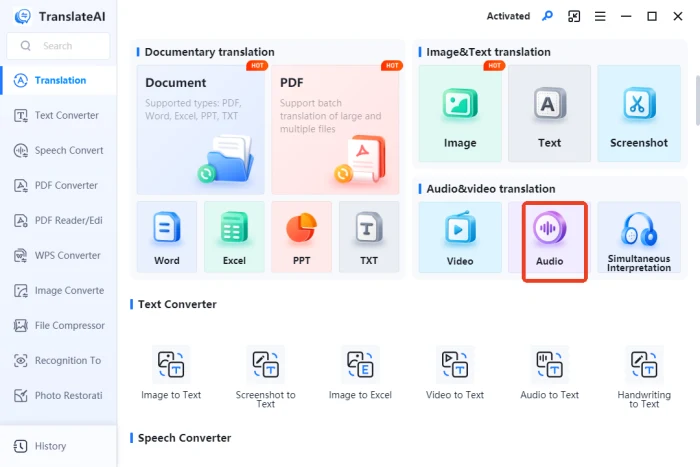
◾ Step 2:Upload your audio file (under 200MB, 3-hour limit).
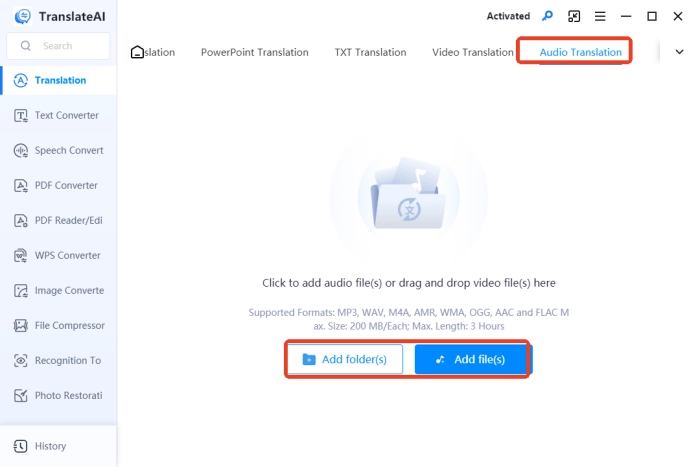
◾ Step 3:Set Spanish as the source language and English as the target.
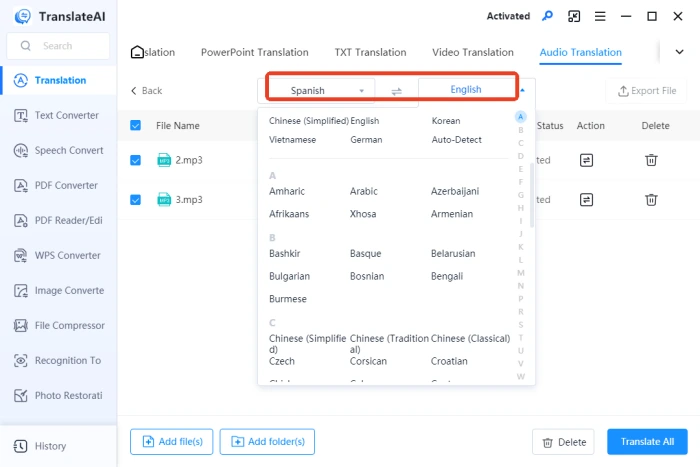
◾ Step 4:Click “Translate All” and wait for processing.
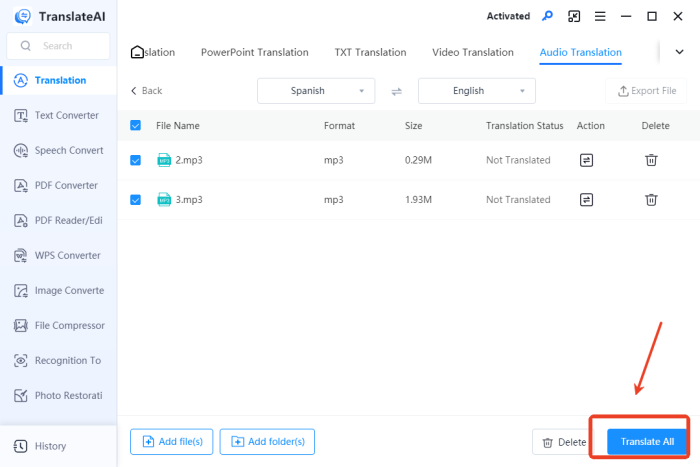
◾ Step 5:Export the translated file with customized settings.
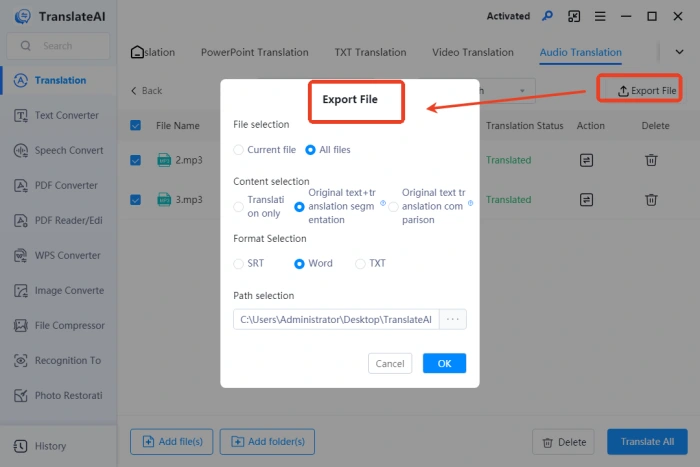
✅Transmonkey
Transmonkey is an AI-powered platform supporting over 130 languages. It handles documents, images, videos, and audio files while prioritizing privacy by deleting data post-translation.

◾ Step 1:Locate and click on “Video Translator” at the top of the interface.

◾ Step 2:Select and add a single target audio file, which should be under 500MB.
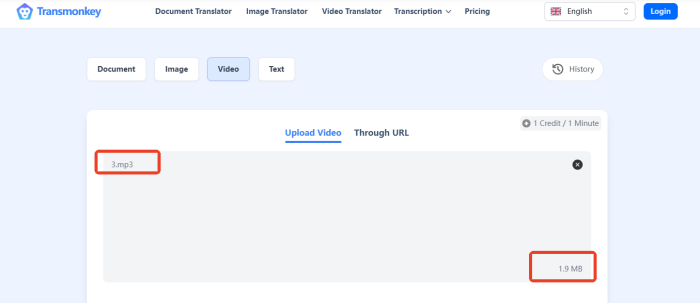
◾ Step 3:Set the target language to “English” and then press “Translate.”
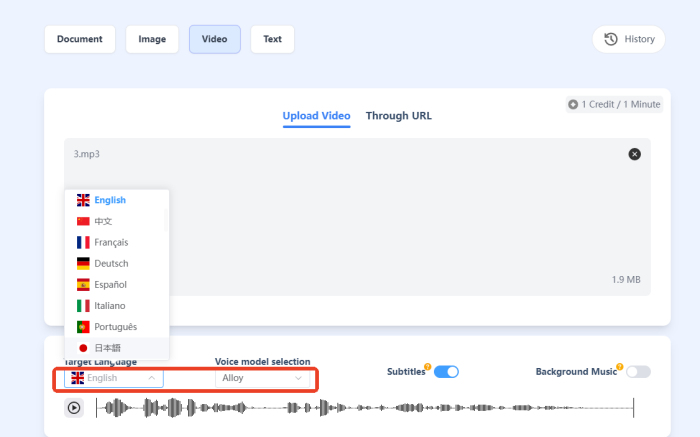
✅Maestra
Maestra is an AI platform offering real-time transcription, translation, dubbing, and subtitling services. It supports over 100 languages and is ideal for education, training, and content creation.

◾ Step 1:Visit the official website and locate the audio translation tool under the “Tools” section.
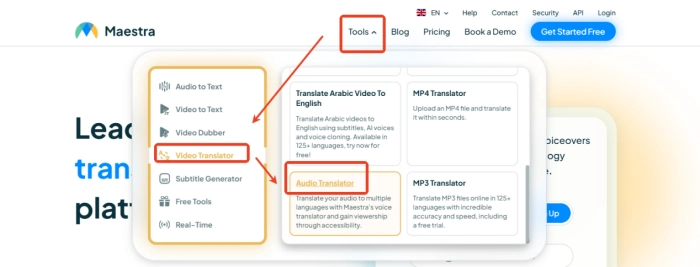
◾ Step 2:Set the source language to Spanish and the target language to English.

◾ Step 3:Upload a single audio file and wait for the translation to complete before downloading the output.
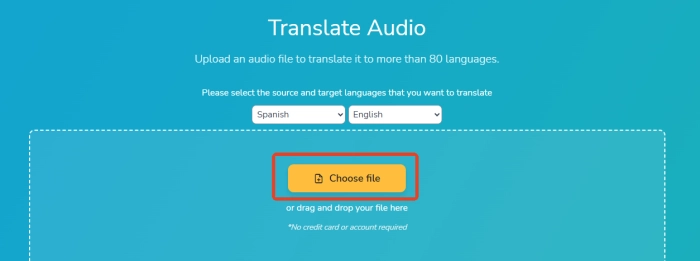
✅EASYSUB
EASYSUB is an online subtitle generator that leverages powerful speech recognition technology to capture speakers’ voices in real time and convert them accurately into text. It also generates matching subtitles and translates them into multiple languages.

◾ Step 1:After opening the site, click on Tools—More Tools—Audio Translator in sequence.
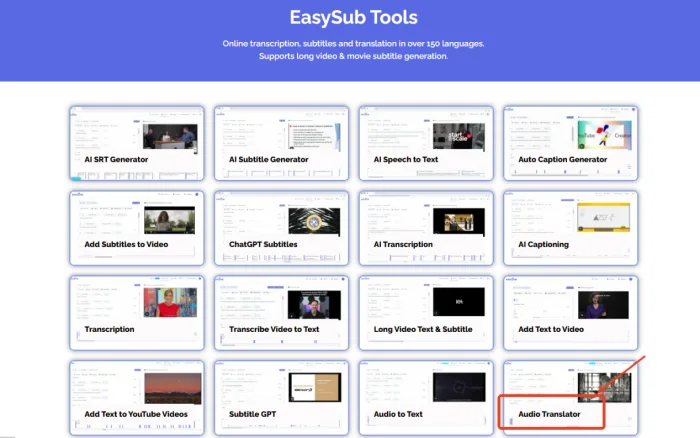
◾ Step 2:Add the Spanish audio file that needs translation or upload it by pasting the URL.
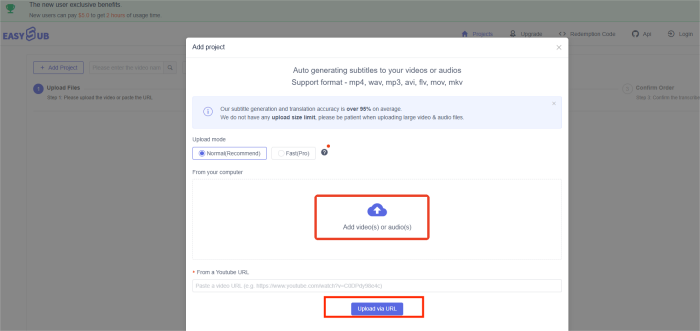
◾ Step 3:After setting the source and target languages, press “Confirm” and wait for the translation to finish.
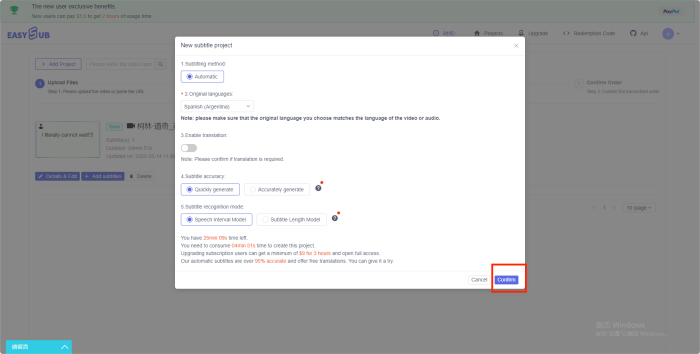
🔑How to Choose the Right Tool?
🔸 Clarify Your Needs🔸
| Select a tool based on your specific requirements, taking into account file types, languages, and target audiences. A tool specialized in certain areas will ensure precise alignment with your goals. |
🔸 Translation Quality🔸
| Try out several popular tools and compare their results to choose the highest quality. Also, consider user reviews and feedback to make a wiser decision. |
🔸 Ease of Use🔸
| Prioritize tools with user-friendly interfaces that are easy to learn. Consider whether they offer features like batch processing and format retention, which can significantly boost translation efficiency. |
🔸 Cost Consideration🔸
| Choose a tool that offers the best value for your budget and needs. For frequent use, investing in professional software may be more cost-effective, while free translation websites are suitable for occasional use. |
📝Tips for the Translation Process
🟠 Respect the Original Context and Cultural Background
| Accurately capture cultural nuances and contextual implications, and convey them appropriately in the translation to avoid misinterpretation, ensuring accuracy and naturalness. |
🟠 Maintain Consistency in Translation Style
| Whether it’s word choice, sentence structure, or tone, maintain consistency with the original style to enhance the overall quality and readability of the translation. |
🟠 Check for Grammar and Spelling Errors
| Pay close attention to grammar and spelling, as these details can affect the accuracy and fluency of the translation. After completing the translation, thorough proofreading and corrections are necessary. |
🟠 Ensure Legal Compliance
| Before translating, verify the copyright and privacy rights of the audio content. Also, adhere to relevant laws and regulations and platform guidelines to ensure the legality of the published content. |
✨Conclusion
🎊Translating audio from Spanish to English is crucial for breaking down language barriers, spreading global voices, and fostering cultural exchange and integration. By mastering effective translation methods and techniques, we can significantly enhance translation efficiency and quality, thereby building seamless bridges for communication among different language groups and contributing to cultural exchange and mutual learning. 🔔Personally, in professional settings, I recommend using TranslateAI to ensure high-quality translation output.




